Mark Sisson's Blog, page 346
March 10, 2013
Weekend Link Love
 Research of the Week
Research of the WeekIn case you needed another reason to avoid vegetable oils, a 2007 study showed that soybean and canola oils sold in the US contain up to 4.2% trans fats (unlabeled).
Among severely constipated human patients, reducing or eliminating their fiber intake reduced or eliminated their affliction.
Interesting Blog Posts
Whatever happened to the digital divide? It’s still there, just in a different form.
Standing desks are cool and all, but what about walking desks? The potential benefits make up for the larger barrier of entry, in my opinion.
Media, Schmedia
Superbugs are spreading in hospitals and nursing homes across 42 US states, and they’re highly resistant to most antibiotics (except for the older, outdated antibiotics that have the tendency to also damage your kidneys).
American eggs would be illegal in British supermarkets, and British eggs would be illegal in American ones. Or, how America’s reliance on technology to make food safer ends up getting it horribly wrong, again.
A slightly different take on BPA from an endocrinologist.
Everything Else
Whatever you do, don’t make stupid mistakes.
Meet Ron Finley, guerilla gardener of South Central LA, where “drive-thrus are killing more people than the drive-bys.” Another choice quote: “Growing your own food’s like printing your own money.”
Recipe Corner
Pork, fennel, and apple meatballs. Simple, easy, delicious.
Your vegetarian friends will love this Brussel’s sprout burger.
Time Capsule
One year ago (Mar 10 – Mar 16)
Will Eating Red Meat Kill You? – Denise Minger rips into the latest study claiming that red meat means certain death.
Can We Feed the World on the Primal Blueprint Diet? – Part 3 – If we wanted to make this work, what would we as individuals have to change?
Comment of the Week
Lots of activities can be done on the floor. Some involve more rug burn than others.
-You’re talking about playing Twister, right? Yeah, that’s gotta be it.
Get All Three Primal Cookbooks, an Apron and More in The Primal Blueprint Chef Kit Today!

March 9, 2013
Coconut Lime Mussels
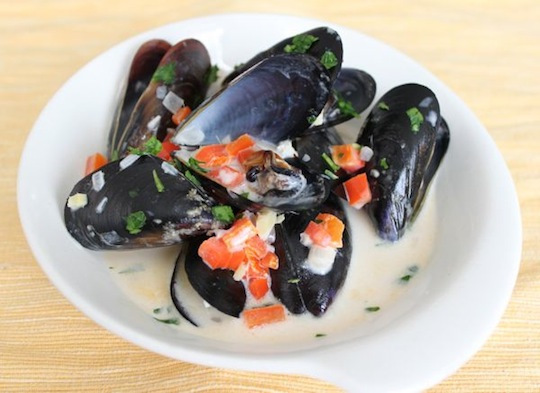 Mussels are incredibly easy to cook and this recipe capitalizes on that fact. Using a handful of simple ingredients and a few straightforward cooking steps, you’ll have a light but really satisfying meal on the table in 30 minutes.
Mussels are incredibly easy to cook and this recipe capitalizes on that fact. Using a handful of simple ingredients and a few straightforward cooking steps, you’ll have a light but really satisfying meal on the table in 30 minutes.
The mussels swim in a creamy coconut broth spiked with shallot, garlic, ginger and lime juice. It can be sipped like soup or soaked up by cauliflower rice. Although perfectly delicious as is, this recipe can be expanded in a variety of ways. Make it spicy by adding a sliced Thai chile or a drizzle of hot sauce; make it meaty by sautéing bacon or sausage with the shallot; make it green by adding a few handfuls of spinach leaves. However you serve it, you’ll love the flavor and the quick prep time.
Serves: 4
Time in the Kitchen: 30 minutes
Ingredients:
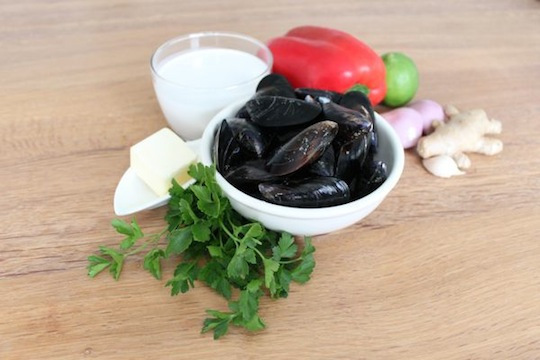
2 tablespoons coconut oil or butter (30 ml)
2 shallots, finely chopped
2 cloves garlic, finely chopped
1 tablespoon finely chopped ginger (15 ml)
1 red bell pepper, finely chopped or cut into thin strips
1 can (13.5 ounces/ 400 ml) coconut milk
3 tablespoons lime juice (45 ml)
2 to 2 1/2 pounds of mussels (1 kg), scrubbed and bearded
1/4 cup finely chopped parsley or cilantro (60 ml)
Sea salt
Instructions:
In a deep pot heat the coconut oil/butter over medium heat.
Add shallots and saute for 3 minutes.

Add garlic and ginger and red pepper.
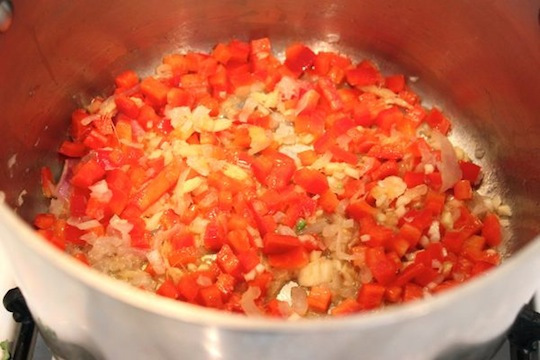
Sauté for 2 minutes then add coconut milk and 2 tablespoons of lime juice.
Bring to a simmer for 5 minutes then add the mussels to the pot. Cover and cook for 3 minutes, until mussels open.
Discard any mussels that have not opened.
Add a pinch of sea salt to the broth, the fresh herb and the remaining tablespoon of lime juice.

Get All Three Primal Cookbooks, an Apron and More in The Primal Blueprint Chef Kit Today!

March 8, 2013
I Am in Harmony with My Body and Mind for the First Time in a Long Time
It’s Friday, everyone! And that means another Primal Blueprint Real Life Story from a Mark’s Daily Apple reader. If you have your own success story and would like to share it with me and the Mark’s Daily Apple community please contact me here. I’ll continue to publish these each Friday as long as they keep coming in. Thank you for reading!
 Hi Mark,
Hi Mark,
It is an honor to be able to submit a Friday real life success story. I have gained so much from your website, books, and the shared stories within. I can only hope that my tale may help someone else start walking on their own primal path.
A decade ago, where I’ll begin my own story, I was so far away from health and a healthy lifestyle that today truly is like a new life for me.
While each present Friday I can enjoy clicking on Mark’s Daily Apple for updates, information, and inspiration, 10 years ago, each Friday I was making a weekly sojourn to my dermatologist where I would be receiving hearty injections of methotrexate to combat a severe case of psoriasis.
I began to exhibit symptoms of psoriasis in my late teens, and it slowly and surely progressed from a few dime size spots, to a head-to-toe calamity by the time I was 30. This left me with inflamed and painful skin, and the added bonus of the startings of psoriatic arthritis, a condition that progressively had me walking and moving about like I had cobbler’s nails in my shoes. Just imagine that your epidermis is an ill-fitted suit, a few sizes to small, and quite unsightly. That’s about where I sat.
Stepping back just a few years more: I was born in England, and moved with my family to America, and Cleveland proper, when I was 8 years old. I was raised, dietetically speaking, having British parents, and American friends, and thus ate a hybrid Britannic/Standard American diet. That included English delicacies such as beans on toast, pork pies, assorted sweets, crisps, and pop, to everything a growing American boy would want: McDonalds, burgers, pizza, and pop. Despite my prodigious food intake, I was always healthy and active, and had those ruddy cherubic cheeks that I though meant good health through my teenage years.
But as time marched on my diet became equally unsightly. Despite working as a cook for many years in a quaint Italian, make-it-from-scratch restaurant, knowing my way handily around a kitchen, and having been trained by great cooks; left to my own devices my diet became, in a word, horrific.
At almost 30 I had begun my career as an outreach social worker, which had in turn springboarded a latent smoking habit to unforseen levels, and left me largely as a “dashboard diner” on a daily basis. I fell into pattern of eating by proximity, meaning if it came near me, I ate it.
It is hard to admit that a not uncommon breakfast would have been a packet of Ho-Hos, a big Pepsi, and a couple of Camels….ughh. Lunch would be something equally sinister, and for dinner, I would prepare a nice carb-laden meal replete with breads, pastas and hearty desserts. I believe I would have eaten a house brick if it was properly seasoned.
During this span of time I gained 50+ pounds. There I was, cigarettes, soft drinks, and a belly full of foods, that were only food in the sense that they can be ingested. It is no wonder my skin and autoimmune system was launching a full stage rebellion against me.
After several repeated blood tests showed that the methotrexate was affecting my liver function, I opted to stop that treatment all together, and just lived, however limited, with what I was beginning to accept as a chronic illness that made each progressive day just a little bit harder.
I would rely heavily on every lotion, ointment, and emollient that I could get my hands on to get me through the day. Most mornings I would find myself having to douse my skin in several lotion concoctions just to be able to get out the door to work, and I’m certain that on a bad day I would have single-handedly affected the strategic petroleum reserves.
Through all of this, most thankfully, my wife was unequivocally supportive and loving, which I credit for really getting me through that trying and difficult time.
It is, as I found out, easy to feel hopeless and lost in a cycle of futile behaviors that only perpetuate each other.

This first photo shows me inflamed and sweating in front of the Biltmore Estate on an otherwise lovely vacation. One of the pains of psoriasis at my degree was that it relegated me to long sleeves and pants on the hottest of summer days. My activity level at this time had been reduced to next to nothing. While I used to love to bike and lift weights in my early 20′s I had since given up on doing either of those, or anything above the most modest level of movement.
I had married my lovely wife during this time, and had begun to see my family physician instead of a dermatologist as I no longer had any health insurance. I was knocking at 250 lbs, had borderline high blood pressure, and any number of other risk factors. My doctor had sagely advised me on losing weight and eating healthy, he also advised me against taking any more oral steroid medications due to risky side effects; the steroids had been a a quick-fix measure I had often fell into yet offered no long-term resolution. At this point, I was just hoping for a break.
I had always vowed that given a chance I’d do my best to get my life back on track. Shortly thereafter I spied a secondhand UVB phototherapy machine for sale locally. UVB therapy treatment’s a time-consuming and expensive treatment that I had never tried before, but always been interested in. I was able to get support from my doctor to begin treatments in my own home.
Within a few weeks, I had begun to clear my skin enough to begin “moving again.” This started off with creaky painful walks , of 1/2 to 1 mile, then 1 to 2 miles. I then made up my mind to quit smoking, which thankfully I did, and then I finally got back on my bike after a 10 year hiatus, pedaling, literally, till the cranks broke off the bike.
Unfortunately, through all of this I still never saw the corrolary between diet and my illness. I was always treating it from the outside in. With ointments, topical steroids, occlusive dressings, but I never was seeing, what I so clearly see now – that what I was putting into my body was the probable cause of inflammation in the first place. I then spent the next several years fighting my way back to relative “health.”

This photo shows me with what I then considered a “healthy meal”- the endless bowl of whole wheat pasta, of course with the obligatory garlic bread.
I was no longer smoking, and I was working out daily, but my diet was far from healthy. Pepsi was still an everpresent companion, as were sugary snacks and heavily processed foods of suspect origins and varieties. I was so jumping-for-joy happy to be moving and back in the land of the living that I still wasn’t putting all the pieces together. My workouts at this time were all over the place. I would spend an hour on the elliptical at full speed, then get so hungry I could eat my own shoe soles, and within 15 minutes of being back home I would have systematically put back on all the calories I just expended. I would “lift weights,” but in essence I would do 150 sets of bench presses and curls, with no compound movements or variety at all.
The fortunate part is that i discovered that the human body is indeed a forgiving thing. After all the toxins I had ingested, and put into my body, I showed huge gains in that first year and a half. Within one year I went from biking one mile painfully to a 100 mile bike ride, from bench pressing 130 lbs to 275. Then from running two miles on a treadmill to my first half marathon (admittedly I couldn’t walk for two days afterwards, but sometimes you need a goal to keep you going). But my workout routine, as thankful as I was for it, felt just like that, routine…
I was still largely tethered to using a UVB machine regularly, still using topical steroids frequently, and still not losing weight despite what I thought was the standard accepted workout. Treadmill, elliptical, lift repeat…..
Then fortuitiously I went to visit my best friend “Ed,” a helluva personal trainer in Chicago. He was supportive as always, and thrilled to hear about my newfound energies, and he handed me a book within a few minutes of arriving called The Paleo Diet. He explained the science behind it and told me first thing I should do when I get home is look at Mark’s Daily Apple.
This, most thankfully, I did, and I quickly devoured all the information I could on The Primal Blueprint, the science and what I saw as a simple approach to the primal lifestyle. I remained in touch with Ed as he guided me to the leaping off point into my full primal escapade. I purchased The Primal Blueprint and cookbook on January 1st, 2012.
One year ago this week I began my primal journey. This included giving up all those things that had been holding me back on truly seeing my full potential.
Dietary:
A Coda for Soda: Since childhood, I had been a Pepsi hound, but when really seeing this is just a calorie and sugar delivery vehicle, it was easy to let go of it. Now it’s water or nothing. Despite its reputation for flammability, Cleveland’s water supply is delicious and clean right out of the tap, and I drink it by the gallon.
Against the Grains: I was always a “bread guy.” I always thought the healthiest part of any meal was that hearty helping of bread; pita, Italian, toast, chips, crusts, bagels, waffles…you name it and I normally ate it by the faceful. I can truly say I don’t miss it at all.
I rediscovered my cooking mojo. I’ve always known how to cook, but now I really and truly appreciate the art and fun of cooking again. I’ve learned so many new recipes from the primal/paleo community that I truly know I will never be hungry again. And I finally realize what food is, and what it isn’t. I won’t go into details, other than that I appreciate the simple delicacies of food more than I could ever have imagined.
And how has this affected me over one year?
Following the 80/20 model, my skin has been 98% clear with no steroids/anti-inflammatory needed, and I’m sure that if/when I go to the next level I will be 100% clear.
I now know what calmness of body feels like. I used to literally feel like a boiler, and all the foods I was ingesting were systematically inflaming me through and through. Now I feel like a…well I can’t think of an exact comparison, but something so much more efficient, tuned up, stable… If you follow the Blueprint, you’ll know this feeling soon enough.
I went from a size 38 waist to size 32, from 215 lbs to 175 lbs. And I have energy for days on end.
I was also able to take those warm-weather beach vacations, something I hadn’t been able to do in a long long time.
Here are two photos of my wife and I for a before and after comparison:


My workouts are also radically different. I left my gym membership and built a primal garage gym: homemade pull-up, dip bar, gymnastic rings, sandbag training, jump rope, dumbbells and kettlebells.
I lift heavy things, run like a middle-aged mountain lion, and do farmer’s walks up and down the yard in all seasons.
A great addition to my workout routine has been my dog (Olive). We go to the park, to run and sprint in the wind, snow and rain. We hurdle up hills, jump, play frisbee, hike and hug. If you model an afternoon at the park after your dog’s behaviors, trust me, you’re having a primal good time.
I work out frequently, with high intensity, for a short or long duration depending on what my body tells me, and always fully enjoy it.
Four months into my primal journey last year I ran a Tough Mudder here in Ohio with great group of people. I finished without worry, and woke up the next day feeling splendid and not even a tweak of soreness; a true testament to the primal workout regimen.


My skin? It is quiet, clean, and natural. I am in harmony, for lack of a better word, with my body and my mind for the first time in a long time. The best part is, I still feel like this is just the beginning. Just one year in and these are my results! I can’t wait for the next year, or the next 20 for that matter. I’m blessed with a beautiful wife, and a beautiful life as these pictures clearly illustrate  .
.
I’d like to think that the improvements make a better husband, friend and social worker.
I can’t say whether the Primal Blueprint will help all those who suffer from psoriasis, but I can truly say it has worked for me and urge you to try it too.
I am indebted to my wife, who supported me through thick and thin, and to MDA for showing me weekly, and daily, how to live the life you truly envision.
Sincerely,
Craig
Grab a Copy of The Primal Connection: Follow Your Genetic Blueprint to Health and Happiness Today!

March 7, 2013
Extrinsic and Intrinsic Rewards, or What Really Motivates You to Be Healthy
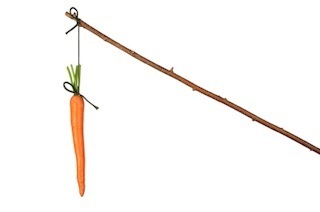 When you look back and think about your health journey (or your life in general), what have been the motivations that got you where you are today? Has it been a competitive spirit? An incessant curiosity? An individual sense of purpose? An ambitious drive? Inherent in these questions are the broader trends of initiative. Do you tend to seek out external challenges, validations, feedback to push yourself, or are you more often buoyed by personal inspiration? What impels you the most: the outcome or the pursuit? For many people, it’s a combination of both, and their answers depend on the activities in question. Nonetheless, knowing what most effectively motivates us in a particular endeavor can change the game in substantial ways.
When you look back and think about your health journey (or your life in general), what have been the motivations that got you where you are today? Has it been a competitive spirit? An incessant curiosity? An individual sense of purpose? An ambitious drive? Inherent in these questions are the broader trends of initiative. Do you tend to seek out external challenges, validations, feedback to push yourself, or are you more often buoyed by personal inspiration? What impels you the most: the outcome or the pursuit? For many people, it’s a combination of both, and their answers depend on the activities in question. Nonetheless, knowing what most effectively motivates us in a particular endeavor can change the game in substantial ways.
We’ve all heard of intrinsic and extrinsic motivations at some point. Although some experts don’t support the dichotomized differentiation, the framework offers a usable guide for examining what we’re driven by in our health efforts.
Extrinsic motivation looks generally outward – to obtaining a specific “reward” (e.g. recognition, award, money, or other concrete benefit), participating in competition, or contributing to a team endeavor. On the flip side, extrinsic motivation also encompasses our interest in dodging an unwanted external consequence. In short, it’s about working to achieve (or avoid) an external outcome of sorts.
Intrinsic motivation, on the other hand, plays off of our internal interests and values. We do what we do not because we’re interested in what we perceive to be a beneficial outcome or reward but because we’re invested in the process itself. For example, we want to train not because we care much about where we finish in a race but because we just love the release of working out – of seeing our usual path, of enjoying how we feel during and after a run.
When it comes to the usual comparison, let’s face it. Sometimes extrinsic motivation gets a bad rap. Extrinsic motivations are often categorized as shallow or unenlightened compared to intrinsic interests. For example, we might be made to feel guilty for working to look good naked, so to speak, but vanity can have its time and place. I think the effectiveness of extrinsic motivation, however, suggests we’re simply human – that we’re a social species capable of learning from one another and responsive to our circumstances. After all, we evolved within an environment of constant reward-penalty feedback.
Intrinsic motivation can fuel our creativity and sense of inner purpose, but it doesn’t negate or diminish the legitimate significance of an extrinsic view. As critical and enriching as intrinsic motivation can be, for example, when excessively imbalanced, it can be isolating for some people. Likewise, many of us eventually come up against a wall when pure interest in the pursuit (e.g. fitness) doesn’t push us to farther distances or new dimensions the way looking outward can. Extrinsic motivation needn’t be just about unbridled materialism or fierce rivalry. It can just as likely put us in meaningful collaboration with one another or give us important perspective on the value or relative accomplishment of our efforts. Sometimes, it can give us a needed change of pace. The fact is competition is fun when it’s fair, and there’s nothing wrong with enjoying a reward or recognition.
When we recognize that human truth and basic effectiveness can be found in both intrinsic and extrinsic incentive, we open ourselves to larger realms of possibility. The question becomes this: how do we harness the benefits of both to optimally foster our motivation for healthy and happy living? I hope you’ll add your thoughts, but here are a few to consider.
Cultivating Intrinsic Motivation
Create a Vision Board
Intrinsic motivation, I think, has a lot to do with personal clarity. What vision do you have for developing your health (or self)? What does thriving look like to you? Use everything from quotes to visuals as you hone your vision.
Keep a Personal Journal
Use the journal to examine what activities you find positive and fulfilling (e.g. a new yoga class, developing your strength with a new resistance training commitment). Get in touch with the subtle personal effects of the changes and progress you’re making. Write about how an activity or new health choice feels for you – what it does to your mood, your sleep, your energy, your confidence. Envision how you’ll go deeper into each goal and continually check in with yourself.
Applying Extrinsic Motivation
Identify Desired Incentives
Again, putting our natural inclination toward extrinsic motivation to work means understanding what kinds of external factors drive us the most. Do you appreciate recognition or enjoy looking good? Some of us might relish competition, while it has others running for the hills.
Seek Out Challenges and Collaboration
Participate in activities like semi-competitive team sports or seasonal gym “challenges” that offer you just enough pressure to push yourself to new gains, enjoy group contribution, and enjoy the opportunity for recognition. Start a photo journal that showcases the positive changes you’re making in your physical shape as well as overall health.
Use Personal Devices or Online Tools for Virtual Challenge
Everything from PaleoTrack to a Fitbit can help you track your progress and enjoy meeting goals, but take advantage of other tools that impose unpleasant results (e.g. lose money you put up front) if you don’t meet a particular goal or that offer a virtual rallying as you work toward an objective.
Now, what say you, readers? Where do you find the motivation to push yourself toward new health endeavors or into deeper, more challenging terrain?
Note: There is a poll embedded within this post, please visit the site to participate in this post's poll.
I hope you’ll take the poll and offer your insights into the sources and strategies of motivation. Thanks for reading, everyone.
Grab a Copy of The Primal Connection: Follow Your Genetic Blueprint to Health and Happiness Today!

March 6, 2013
9 More Reasons You’re Not Losing Weight
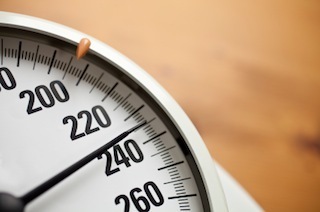 A few years back, I wrote an article explaining 17 possible reasons why you’re not losing weight. It was a troubleshooting guide of sorts, aimed at helping people identify some of things they may be doing (or not doing) that’s causing their stalled fat loss. The etiology of obesity and weight gain is multifactorial, and can be complex. Additionally, we’re all unique human beings. So it can be difficult to pin down one simple cause – or even seventeen simple causes. While unwanted fat loss comes effortlessly to most people that eat according to the Primal eating strategy – as the success stories and hundreds of thousands of positive user experiences indicate – sometimes we inadvertently sabotage our best efforts, stray from best practices, or don’t fully grok what we need to do to become efficient fat-burners. So let’s take a look at nine more possible reasons, shall we?
A few years back, I wrote an article explaining 17 possible reasons why you’re not losing weight. It was a troubleshooting guide of sorts, aimed at helping people identify some of things they may be doing (or not doing) that’s causing their stalled fat loss. The etiology of obesity and weight gain is multifactorial, and can be complex. Additionally, we’re all unique human beings. So it can be difficult to pin down one simple cause – or even seventeen simple causes. While unwanted fat loss comes effortlessly to most people that eat according to the Primal eating strategy – as the success stories and hundreds of thousands of positive user experiences indicate – sometimes we inadvertently sabotage our best efforts, stray from best practices, or don’t fully grok what we need to do to become efficient fat-burners. So let’s take a look at nine more possible reasons, shall we?
1. You’re engaging in too much mindless eating.
If you asked most people what made them overweight in the first place, it was that sneaky, tricky combination of eating and, well, doing everything else but focus on the food. It’s eating while watching TV. It’s eating while driving (I’ve seen a man eat a bowl of cereal on the 405). It’s eating while cooking (not tasting to stay abreast of the dish; full-on eating). It’s popcorn at the movies. It’s beer and wings and more beer during the game. In other words, it’s mindless eating. Eating that feels like breathing, like something you just do. You take a few chews, rarely enough to qualify as real mastication, and down the hatch it goes, with a follow-up handful close on its heels. Since increased frequency of eating (i.e. mindless eating or snacking) is strongly associated with the United States’ steadily increasing average energy intake, it’s plausible that mindless eating leads to eating more food.
Be more mindful when you eat; practice mindful eating. Eat food with others, sit down to dinner, take the time to appreciate the food you’re eating. Just because you’re scarfing down grass-fed beef and pastured eggs doesn’t mean you can get away with mindless consumption.
2. You’re eating too many “pleasure foods.”
Paul Jaminet really has a knack for coining phrases, doesn’t he (“safe starch,” anyone?)? A lesser known one is “pleasure foods.” These are things like nuts, dark chocolate, and raw honey – all foods that have gotten the stamp of Primal approval in the past, all foods that are calorically-dense and easy to overeat. This is hard to grasp, because these foods also confer some health benefits. Nuts are rich sources of micronutrients like magnesium, vitamin E, and selenium, and multiple studies suggest that nuts help weight loss. Dark chocolate got an entire post devoted to its impressive polyphenol content (and its fatty acid profile isn’t too bad, either), while honey is quite possibly the best sweetener around. At the very least, it and its bevy of bee-related compounds outperform other sweeteners like maple syrup and plain sugar and result in fewer metabolic issues. All that said, these foods are delicious, packed with calories, and can be overeaten, particularly because they have the reputation as “health foods.”
If you’re not losing weight, moderate your intake of these foods.
3. You’re eating too little.
It’s well-established that prolonged dieting – taking in fewer calories than your body expends – will eventually lead to a downregulation in the basal metabolic rate. This is simple stuff, really. Reducing your food intake will lower your body weight, usually, but it’s not a simple matter of dropping them lower and lower as you lose weight. The body isn’t a passive thing that you’re merely adding to and subtracting from. Instead, it’s a living, breathing, reacting, adapting entity that responds to the lowered caloric input by lowering its energy expenditure. Since you can’t lose weight forever (you’re not just going to waste away into nothingness), perpetually lowering your caloric intake will eventually work against your desire to lose weight.
Instead of sitting at a chronic caloric deficit, consider cycling your caloric intake. Eat less one day, more the next. You might also look into periodic refeeds, which may be able to kickstart a stalled weight loss.
4. You’re under “hidden stress.”
In the previous article, I explained how stress can make us gain weight, or stop losing it. Cortisol – which we release as a part of the stress response – inhibits weight loss, catabolizes muscle, worsens insulin resistance, and promotes the storage of fat. Although back then I was referring to the obvious sources of stress in our lives, like bills, traffic, jobs we hate, bosses we hate, relationship strife, there are other “hidden” types of stressors that result in the very same physiological responses as obvious stressors cause. Foremost among the hidden stressors is the lack of nature exposure. In the literature, researchers often speak of “forest bathing,” or spending a day or two or three in a forest setting to reduce cortisol, enhance immune function, and improve glucose tolerance. I prefer to look at this a different way. Instead of nature exposure being a positive anti-stress agent, urban living is an active stressor. Spending a day in the woods is a return to normalcy rather than an “intervention.”
If you’re not doing this already, take a day or two out of the week to get outside, preferably amongst unkempt, wild nature. It needn’t be a forest or a craggy cliff. The beach, the desert, or even a park will do just fine. In a pinch, you can even listen to nature sounds and look at nature scenes on your computer.
5. You’re too focused on diet to the exclusion of all else.
When you realize the wool that’s been pulled over the collective eyes of society regarding nutrition, it’s easy to become obsessed with your newfound knowledge. It’s easy to stay up late, night in, night out, perusing nutrition blogs, reading comment sections, devouring PubMed articles. You’ll hear about some arcane but totally essential nutrient and think that it’s the Answer. Am I getting enough magnesium? What about boron – I need some boron, right? How about vitamin A? Should I go for the preformed retinol or rely on the conversion from beta-carotene? Should I drive fifty miles out of town to get goose liver, or should I just take a vitamin K2 supplement and call it a day? Choline – that’s the stuff! Nothing but liver and egg yolks from here on out!
Diet is the obvious primary arbiter of body composition, but there’s more to life than worrying about what you put in your mouth. It’s counterintuitive, and there aren’t any randomized controlled trials showing it, but you might have more success just enjoying life, getting some exercise, and hanging out with good people instead of micromanaging your nutrient intake. Relax.
6. You’re getting too much exercise.
Although regular exercise is a necessary component of a healthy lifestyle, and smart training that includes lifting heavy things, walking lots, and sprinting occasionally can speed weight loss and improve body composition, there is such a thing as too much exercise. After all, effective exercise is effective because it’s stressful, because it challenges our physiology and propels us to rise to the occasion and improve ourselves by getting stronger, faster, and with more lean mass and less body fat. Taken to the extreme, exercise becomes a chronic stressor and a steady source of cortisol release (which as we discussed above makes us insulin resistant and promotes the accumulation of belly fat). Chronic stress in any form can also induce a hypothyroid-like state, where metabolic rate is lowered and weight loss slows or stops altogether, and exercise-induced chronic stress is no different.
Try to stick to the 4,000 calories a week (soft) limit, especially if you find your weight loss stalling.
7. Your macronutrients and training are mismatched.
For most people who stay reasonably active, doing lots of low-level movement as well as some lifting, a low-carb Primal way of eating is generally the most effective way to lose body fat. It tastes good, it’s easy to stick to, and, most importantly, it works. But some people like to push the envelope. They like waking up early and going for a run, then coming home at night and hitting the weights. They’re avid CrossFitters. They like seeing how far their bodies can go. They’re concerned with performance, above all else, and they want to maximize every last drop of physicality their bodies can muster. In that case, more dietary carbs are probably called for – especially if they’re trying to lose weight at the same time. Certain activities just require glycogen. I do plenty of activities that use up glycogen, but I’m not doing them day in, day out, so I don’t need to eat a lot of carbs.
If you are, if you’re doing WODs every day and playing in a basketball league on the weekends and doing jiujitsu twice a week, you’ll need to replenish those glycogen stores more often or else risk that chronically-stressed state that stops weight loss.
8. Your eating schedule is too disordered.
I tend to get hungry at different times throughout the day, and I have no issues eating meals at different intervals depending on when hunger strikes. That seems to be pretty typical. Although many Primal eaters relish the freedom from having to keep snacks on hand in order to stave off hunger and enjoy the fact that they can skip a meal or two and just rely on their hunger signals, there is a considerable amount of evidence that maintaining a regular eating schedule can improve the metabolic response to meals in some people. Women in particular seem to benefit most from a “regular meal pattern.” In one study of lean women, an “irregular” meal pattern resulted in lower postprandial energy expenditure than a regular meal pattern. In another study, lean women who ate meals on a regular schedule had better insulin sensitivity and improved blood lipids. And in one other study of healthy obese women, regular mealtimes increased postprandial thermogenesis, insulin sensitivity, and blood lipids.
Sometimes, you might need a little order to your eating, whether you’re IFing or not. And that’s totally fine.
9. You’re actually at a healthy weight and your body is “keeping” you from dropping any more.
I know, I know: your body is a huge jerk and he says mean things to you. But sometimes the body knows best. Sometimes, our current body composition is where we’re supposed to be, even if we only have a four or a two-pack (or none at all). Recall the natural bodybuilder who, upon dropping from 14.8% body fat to 4.5%, also dropped his metabolic rate, his body temperature, his heart rate, his testosterone levels, and his moodiness. Recall that women deposit fat differently than men and actually need some body fat for optimum fertility and health. Instead of obsessing over a few more percentage points on the body fat scale, think about how good you’re feeling, how your health issues have cleared up, and how you enjoy movement more. And if you want to alter your body composition, focus on addition – lifting heavy things, sprinting – rather than subtraction. You might be right where you’re supposed to be.
One final point: Note that I’m not saying eating too few calories or exercising too much or focusing too much on diet to the exclusion of all else will make you gain weight. I’m saying that it can lead to or exacerbate a stall in your weight loss. It’s a small distinction, but an important one.
That’s it for today, folks. Anything look familiar? Anything jump out at you? What have I forgotten? Be sure to skim the last article after reading this one to make sure it’s not something I’ve already covered.
Thanks for reading!
Grab a Copy of The Primal Connection: Follow Your Genetic Blueprint to Health and Happiness Today!

March 5, 2013
Floor Living: Do You Spend Enough Time on the Ground?
 Several weeks ago, I asked readers how much floor living they did and linked to an interesting blog post from Chris Highcock discussing the “archetypal postures” of ground-based sitting, squatting, and kneeling. My interest persisted, and I thought a full-on post about the potential benefits and logistics of spending more time on the floor would be fun and helpful.
Several weeks ago, I asked readers how much floor living they did and linked to an interesting blog post from Chris Highcock discussing the “archetypal postures” of ground-based sitting, squatting, and kneeling. My interest persisted, and I thought a full-on post about the potential benefits and logistics of spending more time on the floor would be fun and helpful.
I’ve found that there aren’t very many studies examining the effects of floor sitting/kneeling/squatting on health, posture, or pain. You’ve got the “stability ball literature” (long story short: sitting on a stability ball tends to “increase the level of discomfort”), but sitting on an inflated unstable sphere is more physiologically novel than a regular chair. I’m not sure there’s much benefit and it looks pretty silly. (But if it works for you…) There’s also a brief study that showed sitting in a backless chair improved levels of consciousness in patients with prolonged consciousness disturbance. For the most part, though, it’s a pretty barren landscape of research.
I think that’s okay. I’m not entirely convinced we always need research to confirm what we already (should) implicitly know.
Sometimes hard data isn’t really needed, especially when you consider two unassailable facts about our relationship with the floor. First, individually, we all start out on the floor. As babies, we lie there, essentially kicking things off as eating, pooping sacks of wiggling, basically immobile flesh. Then, we graduate to flipping over onto our stomachs, lolling our heads around (once we develop sufficient neck strength), crawling toward vacant electrical sockets, hesitantly standing, and finally walking. It’s on the floor that we learn to move. We may not be doing terribly complex or impressive stuff down there, but that first year or two is incredibly formative for the rest of our movement lives. We’re building a foundation made primarily of contralateral crawling and “tummy time.” Graduating beyond the floor to full on bipedalism doesn’t mean we should totally ignore where we came from.
Second, chairs are a recent invention. Folks as early as the ancient Egyptians had them, but they were a luxury item reserved for the upper classes. Your average Neolithic human sat on chests or benches until chairs became a mass-produced staple that everyone could afford. Earlier than that, for most of human history, formal-sitting furniture simply didn’t exist. Paleolithic posteriors surely rested upon rocks and logs and stumps when the opportunity arose, but those aren’t the same as having permanent fixtures that allow you to take a load off whenever you want. Human bodies were not designed with chairs in mind. We did do a lot of lounging around – I’m not arguing we never stopped moving or anything – but we did so on the ground, rather than on a bunch of folding chairs.
Sitting down in a chair does funny things to our bodies. It stretches out our glutes, making them inactive, loose, and weak. People by and large no longer know how to activate their butt muscles due to excessive amounts of chair sitting. Sitting in a chair also keeps the hip flexors in a short, tight, contracted position for extended amounts of time, which can inhibit full hip extension and lead to that hunched over position you often see older folks shuffling around with. And that’s not even mentioning the extensive (and growing) literature showing how sitting for too long increases mortality and degenerative disease, which I’ve covered in plenty of posts and Weekend Link Loves. This post isn’t really about that, anyway.
What might be most important, though, is what sitting in a chair doesn’t do. It doesn’t allow us to rest in the full squat position, an ability we’re born with but quickly forget how to do. It doesn’t let us do much of anything. Sitting becomes a totally passive act, where we’re slumped over, shoulders rounded, feet twisted up and resting on the chair legs, totally dependent on the structure of the chair to support our weight – rather than using our musculature and arranging our skeletal system in such a way that we support ourselves. Doesn’t it seem inconceivable that an animal – any animal – would evolve to require furniture in order to rest comfortably without incurring a disability?
That’s partly why it makes some sense to hang out on the floor more. We need the “stress” of supporting our own body weight and making sure our structures are in alignment. Here are a few positions to try out:
The squat – The default resting position of humans. Kids can do this easily, but once they start going to school and sitting in a chair for six hours a day, they lose it. The goal here is to get your heels on the ground. Resting on the balls of your feet is easier, but it’s harder on your knees and thighs. The heels-down squat, which requires more flexibility but distributes the pressure across your hips, is far more sustainable. Check out the ease with which these Hadza Bushmen are able to rest in the full squat, as well as their ability to move in every direction from that position. If you’re having trouble, here are some nice tips from Todd Hargrove.
Seiza – The formal way to sit in Japan, resting on the lower legs, butt on heels. Placing a small pillow or rolled up towel under your knees can make the transition easier, especially if you have a bad knee or two.
Half kneel – Like seiza, except one of your feet is on the ground, heel down, in front of you in a squat position. Like these guys.
Crossed legs – For many people, this is the most comfortable, natural way to sit on the floor. You can place your feet flat against each other, cross at the ankles, or place your calves against each other. You can even go full lotus. There are many variations, but here’s the most basic way.
Crossed leg variation – This is one my favorite ways to sit. From the basic crossed leg position, place one hand flat on the floor and lean on it. Bring the opposite leg up and place the foot flat on the floor. Your opposite leg will be in a squat position. Switch hands and legs if it gets uncomfortable. It looks like this (except without the creepy eyes) or this. Or this (even better).
Make up your own – Human limbs are funny, bendy things. We can contort ourselves into lots of positions, and as long as you’re on the floor, supporting your own weight and feel comfortable doing it, it’s difficult to hurt yourself. Our bodies are good at giving feedback before things go really wrong. If your arm starts to go numb or your toes get tingly, switch it up! Try coming up with some of your own variations for sitting on the ground and report back.
Crawl – Contralateral crawling is one of the most fundamental ways to move. It’s a strong developer of shoulder and hip mobility and strength, and it’s simply a fun way to see and experience the world.
Now that you have some idea of what to do when you’re on the ground, I’d like you to spend the next week doing as much floor living as possible. I don’t expect you to ditch the office chair and roll around the ground while at work, but I do expect you to get in some quality floor time when you’re at home.
Watch TV on the floor. There’s nothing inherently wrong with TV. Sure, it can be taken to the extreme and crowd out active living, but it’s arguably a golden age of television as far as quality goes. The couch sitting, though, is what gets you.
Eat dinner on the floor. This isn’t something I created out of thin air; plenty of cultures eat dinner on the ground.
Try different positions. You’ll probably find that floor living is a constantly shifting existence, where instead of remaining in the same position for hours at a time, you’re moving around all the time without even trying. You’re switching from the right arm to the left arm to the right elbow to the full lotus position to the half kneel to the full kneel to the full squat just in the first two hours.
Practice moving between positions. Go from standing to a half kneel to a kneel to a seiza to a kneel to a half kneel to standing.
Practice standing up. We can’t live on the floor all the time. Sometimes, we need to stand up and get on with our lives. A smooth transition between floor living and standing is key to health and mobility. For an example transition, check out one of my buddy Erwan’s (of MovNat) methods.
Spend at least an hour a day sitting on the ground and another fifteen minutes practicing different ways to move between positions and another fifteen practicing how to stand up and sit back down. Shoot for ten minutes of crawling, too. You can do most of these things while doing other things, like watching TV or reading or talking, so it’s not like you’re wasting time. My guess is that you’ll take to this like a fish to water.
Why is this so important? The way we sit, and where we do it, changes the function of our bodies. It even alters the length of musculature. In countries where squatting and other forms of floor living are seamlessly weaved into everyday life, people still retain the mobility to do all that stuff into old age. I’ve got a buddy from Thailand who moved over to Hollywood as a teenager in the late sixties and still retains the ability to sit in a full squat, painlessly and effortlessly. This guy is an avid user of chairs and everything Western; not a gymgoer at all, and he’s never even heard of a foam roller or Mobility WOD, but because he got the right floor living experience during the formative years, he can still squat and move around on the floor. Unfortunately, for many of us in Western countries who stopped floor living right around age four or five, we may never quite get there – but we can certainly do a lot better than we are now.
Let’s hear from you guys. How do you handle yourselves on the floor? What’s your favorite go-to position?
Grab a Copy of The Primal Connection: Follow Your Genetic Blueprint to Health and Happiness Today!

March 4, 2013
Dear Mark: Obesogens, Tots Who Hate Veggies, and Pregnancy Recovery
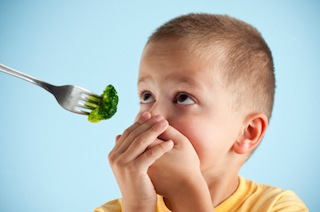 For today’s edition of Dear Mark, I’ve got three topics for you. First are the obesogens, those endocrine-disrupting chemicals that permeate our environment, our foods, our consumer products, and even our bodies. They sound scary and terrible, but how much should we be worrying about them? Next up is the tot who hates his veggies, as classic a trope as any other. Should we be force feeding these kids broccoli, collard greens, and butternut squash at all costs? Or should we take a more laissez faire approach and let them develop their tastes on their own? Finally, I discuss the importance of proper pregnancy recovery, especially in regards to lifting heavy (and not so heavy but extremely wiggly) things.
For today’s edition of Dear Mark, I’ve got three topics for you. First are the obesogens, those endocrine-disrupting chemicals that permeate our environment, our foods, our consumer products, and even our bodies. They sound scary and terrible, but how much should we be worrying about them? Next up is the tot who hates his veggies, as classic a trope as any other. Should we be force feeding these kids broccoli, collard greens, and butternut squash at all costs? Or should we take a more laissez faire approach and let them develop their tastes on their own? Finally, I discuss the importance of proper pregnancy recovery, especially in regards to lifting heavy (and not so heavy but extremely wiggly) things.
Let’s go…
Hi Mark,
I’ve been reading for a couple months now and I’ve recently come across a couple of articles on obesogens. While I don’t have the articles, I can explain what they are. Obesogens are chemicals that are supposed to disrupt normal homeostasis and metabolism and lead to obesity. Do you have any information on these chemicals?
Thanks!
Dalton
According to some people, almost everything is an obesogen. You’ve got phthalates in paints, inks, shampoo, cosmetics, pills, detergents, sex toys, and emulsifying agents. You’ve got BPA in seemingly everything. You’ve got pesticides in conventional produce and animal products. And while it’s true that the modern world is fraught with obesogenic chemicals that mimic hormones, bind to their receptors, disrupt metabolism, and affect gene expression, I don’t think we need to lose sleep over it.
The primary obesogens remain the classics: grains, refined sugar, and seed oils (and too much of all of them); inactivity; poor sleep; and chronic stress. Before you go installing a housewide reverse osmosis filtration system to remove any obesogens in the tap water, allowing only chemical-free produce and meat to pass your lips to avoid all pesticides, banning all plastics from your home to avoid all potential xenoestrogens, handling receipts with chainmail gauntlets to avoid the BPA, catching your own fish with just your hands to ensure it’s truly wild and to avoid BPA leaching from nets, and making your entire kitchen cast iron, get the traditional obesogens under control. The best thing about it? We actually can control our exposure to them.
The fact is that we live in this world, and we have to deal with it. If we want to get our money back and return a product, we’ll need to hold on to that receipt. If we want grass-fed meat at a good price, it may mean buying it in bulk and having it shrink-wrapped in plastic. We need to breathe and drink, even if the air contains pollutants and the water contains obesogenic chemicals. Most of all, though, we have to live. We can’t go through our lives scared of everything, afraid to do anything, paralyzed by overanalysis, saturated with stress hormones from worrying about everything we can’t control or completely avoid. Do the things you love to do, take the basic precautions (look for BPA-free products, use glass instead of plastic, buy organic and local when possible – especially when dealing with the Dirty Dozen), limit the use of cosmetics or find or make natural products, spend time in nature away from pollution, avoid products that contain phthalates when possible, buy quality meat and seafood, burn incense instead of use air fresheners, those sorts of things), and don’t freak out about things that are out of your control. You can’t dodge wifi signals or cell phone radiation (but you can turn your cell phone and router off, if you worry about that sort of stuff). The very fact that you’re aware of them and take simple steps to avoid them puts you ahead of the game – without all the added stress of outright militant avoidance.
Dear Mark,
I was wondering if you are aware of any ‘evolutionary’ reason why many toddlers do not like vegetables. I remember once hearing a doctor speak on the Oprah Show, who said that childrens’ taste buds are designed to taste vegetables and some fruits as particularly bitter, to prevent children from experimenting and trying all sorts of plants in the wild, as some of those plants may be poisonous. Do you think that there is any merit in this argument, and that childrens’ dislike of vegetables is some sort of inbuilt survival mechanism? I am wondering how essential it is to try to ensure my very fussy toddlers eat vegetables, or if they were somehow ‘designed’ not to require them during the first few years of life. Dinner time is very stressful with my toddlers absolutely refusing to eat anything green (or red or orange for that matter), even if it is hidden. They would rather not eat at all. Of course, they eat plenty of grass fed meat, organic chiken and fish. Most evenings they just eat a dinner salmon or chicken, with nothing else, as they will not eat the sweet potatos, vegetables or fruits I am offering them, and I will not offer them bread or pasta.
Thanks
Vicki
Among humans, the youngsters (babies and toddlers) are the most intuitive eaters around. They’re unaffected by fast food advertising. They’re not subject to pressure from peers toting bags of Gogurt, chips, and Lunchables.
For that reason, I’m not too worried about a little kid who hates veggies.
Look, vegetables are bitter. They contain various toxins, and as adults, we’ve learned to appropriate and appreciate those toxins and turn them into full-fledged hormetic stressor nutrients. All those phytochemicals that abound in colorful vegetation that Primal and vegan eaters alike champion? They’re actually toxins that induce a hormetic response from our bodies and upregulate our antioxidant systems, thereby improving our health. But we’re adults. We’ve been eating these foods for a long, long time. Even if we don’t exactly love the taste – but most of us do learn to love the taste – even if they’re still kinda bitter, we know that it’s for the best. We can rationalize eating something that might not taste great because we know that it will improve our health. Eventually, we might even learn to honestly enjoy the taste.
But a toddler? A toddler just has access to the basic senses, which he’s still figuring out. It’s only been a year or two that he even got a handle on all that sensory data streaming through his eyes or ears, or interacting with his tongue. He’s not going to enjoy a sip of $200 wine, and he’ll probably turn up his nose at the sauteed dino kale you’re urging him to eat, regardless of its freshness. He’s not going to rationalize the consumption of a bitter vegetable for his own good, because it’s icky. Icky trumps all in toddlerland.
That’s could be a good thing, too. It may be that small kids are less equipped to deal with hormetic stressors (whether they’re plant polyphenols or light bursts of radiation) than we are, and their tastes are constructed thusly. The hormetic threshold could be a whole lot lower in tots.
Besides, forcing him to eat the vegetables will only make him develop a complex about them that will likely persist well until adulthood. I’m not saying you shouldn’t offer them to him. Don’t give up; try new ways of preparation. Use plenty of healthy fat, which has been shown to increase a child’s appreciation of vegetables. Just don’t wage war at the dinner table.
Keep feeding him quality animals (go for some liver and eggs too, maybe?). If he won’t do anything colored, how does he feel about white foods? Regular old white potatoes and bananas are good substitutes for sweet potatoes. White rice (particularly if you cook it in real bone broth and douse it in egg yolk) can be an inoffensive choice, too, that’s far superior to the more problematic grains. Growing kids need calories, period. They shouldn’t be on a zero-carb diet unless medically indicated.
Hi Mark,
LOVE your posts about babies and families but I couldn’t help but worry a little about the baby wearing one. Lots of Mamas are ignorant of the need to let their bodies recover from childbirth before resuming heavy lifting (yes even a newborn baby is heavy). There is a lot of softening of muscle, ligament and, well, everything, during pregnancy and it takes a while to get back to normal (well, the new normal). So many hormones and so much extra care is needed!
I ignored this information after giving birth like a superwoman (efficiently giving birth then straight into business as usual) and ended up having to have some serious reconstructive surgery.
Perhaps some kind of follow-up on post-pregnancy care of the mother?
That’s a great point. You can’t – or shouldn’t – just pop up from giving birth and resume full activity levels. There are a few reasons for this. First, throughout pregnancy, a hormone called relaxin is secreted. In order to make delivery easier, relaxin promotes the loosening of ligaments and increased joint laxity, particularly in the hips. Hip mobility is important for athletic function, but hypermobile hips can leave you unstable and prone to injury. There’s evidence, for example, that higher serum levels of relaxin are associated with an increased risk of ACL tears. The laxity of the patellar tendon is also associated with serum relaxin levels. Relaxin takes awhile to normalize following pregnancy.
Second, very few women maintain full activity levels during pregnancy, particularly in the third trimester. What this means is that new mothers haven’t been very active for several months and are essentially detrained. Resuming their normal exercise routines in a detrained state will increase the chance of injury. At the very least, you won’t be able to do what you previously could do. Take it easy and act like you’re new to this exercise stuff – because you kind of are!
Third, pregnancy depletes nutrient stores. You’ve essentially spent nine months constructing an entirely new, 7 or 8 pound human being from a small cluster of embryonic cells. You’ve built a musculo-skeletal system, a full set of organs, a human brain, a cardiovascular system, a nervous system, and everything else a human requires… from scratch! As far as your pregnant body is concerned, building that baby is top priority. Dietary deficits mean the required nutrients will be pulled from the mother. It’s just as important to keep eating healthy food and otherwise taking care of yourself (sleep, stress, etc) after the baby is born to keep your body nourished, to recover nutrient stores from the pregnancy, and to maintain a healthy flow and composition of breastmilk. Some women even continue to take prenatals following pregnancy. Your body will regenerate its depleted stores (of, for example, bone mineral density) given enough time and a good diet, but the immediately post-pregnancy period is a vulnerable one.
Fourth, your abdominal muscles – the ones that maintain a neutral, strong, cohesive core that’s resistant to all manner of forces – are stretched out and loose. There was a baby in there. Relaxin was (and still is) coursing through your veins. You literally won’t be able to stabilize your body against loads as well as before, even if those loads are in the form of a ten pound baby strapped to your chest.
Every woman is different, and every woman will have a different recovery time following birth. The important thing is to be aware of your body’s lingering changes. Relax. Take it slow. Get lots of sleep. Hang out with your kid and partner. Opt for walks over sprints and body weight over weights, at least for now. Be careful hoisting that ten pound wriggling weight around; keep it close to your center of gravity (and breasts, which the baby will appreciate) whenever possible.
That’s it for today, guys. Thanks for reading and be sure to leave your thoughts in the comment section!
Get All Three Primal Cookbooks, an Apron and More in The Primal Blueprint Chef Kit Today

March 3, 2013
Weekend Link Love
 An important article from the Caltons on the deception of food science and what we can do about it.
An important article from the Caltons on the deception of food science and what we can do about it.
Research of the Week
A week’s worth of bad sleep switches off hundreds of genes vital to protecting us from cancer, obesity, heart disease, and other degenerative diseases.
When you do switch to barefoot running, make sure you make the transition extremely carefully; a new study found that runners who switched over to Vibrams without changing anything about their routine were at a greater risk for foot injuries.
Interesting Blog Posts
The synthetic diet revolution (the “perfectly balanced” drink is called, of course, soylent).
Media, Schmedia
Men’s Journal talked to me (and several other people you might recognize) about Primal living awhile back, and the piece has just gone live.
And yes, you can be vegetarian and still go Primal. It just might be a little harder.
Between homework, busy schedules, and high prices, kids and parents are finding precious little time to eat real food with each other after school and before bed. The fact that kids are subjected to “crunch time” is just sad.
Everything Else
My Raw Brah buddy did a great interview with Ido Portal, mover extraordinaire. Check it out and try not to get inspired…
A lipid researcher with over six decades of experience says that dietary cholesterol is in fact good for your heart, as long as it’s not oxidized. Other things to watch out for include frying foods in reused oils, eating lots of polyunsaturated fats, and smoking.
Recipe Corner
This recipe makes me want to go back to Hawaii soon. Who am I kidding? Hawaii makes me want to go back to Hawaii soon.
Even if you don’t normally like offal, Grandma Ginsberg’s chopped liver will make you howl. You may be hysterical naked, but you won’t be starving hysterical naked after eating this dish.
Time Capsule
One year ago (Mar 3 – Mar 9)
Knowing Yourself: The Importance of Understanding Who You Are – This is just the basic starting point.
Can We Feed the World on the Primal Blueprint Diet? – Part 2 – How would the logistics work out if we tried something like this?
Comment of the Week
Buy some paper chef hats. (Cheap on amazon). Give him the option of wearing the hat when he helps. The hook being, if he accepts and wears the hat then he is a chef. Explain that a chef must taste the ingredients and the final dish to make sure it is tasty because that is a chefs job. Plus they can draw/color on the hat too.
-Paleo Bon Rurgundy isn’t just funny, folks. He’s got great tips too.
Get All Three Primal Cookbooks, an Apron and More in The Primal Blueprint Chef Kit Today!

March 2, 2013
Meat and Vegetable Skewers in Basil Marinade
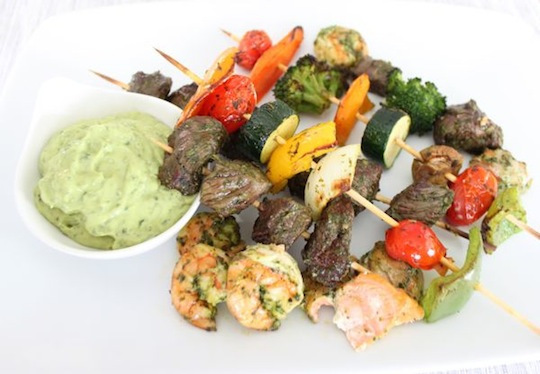 When the whole family helps prepare a meal, cooking dinner feels less like a job and more like a party. Skewers are especially fun to cook because they allow kids to create and personalize their own meal rather than be handed food that someone else chose for them.
When the whole family helps prepare a meal, cooking dinner feels less like a job and more like a party. Skewers are especially fun to cook because they allow kids to create and personalize their own meal rather than be handed food that someone else chose for them.
The more meat, seafood and vegetable options you provide, the better. It gives both kids (and adults) a chance to be creative and adventurous. Don’t exclude proteins or veggies that you think your family won’t eat – you might be surprised by the colorful and healthy skewers they put together.
This recipe plans everything out for you, combining a wide variety of proteins and vegetables in a flavorful basil marinade. The avocado sauce served on the side is optional, but most kids love to dip their food into something. You can also consider serving homemade Ranch Dressing, ketchup, or mayo on the side.
Divvy up cooking tasks the best you can. Washing the produce, pouring the marinade over the vegetables and mixing it in with their hands are good tasks for little ones. Older kids can cut meat and veggies and make the dipping sauce. Skewering is the fun part and kids can quickly enjoy the fruits of their labor; cooking the skewers takes less than 15 minutes.
Serves: 4, with possible leftovers
Time in the Kitchen: 30 minutes to 1 hour of prep, depending on how many people are helping, plus 12 to 15 minutes to cook the skewers
Ingredients:
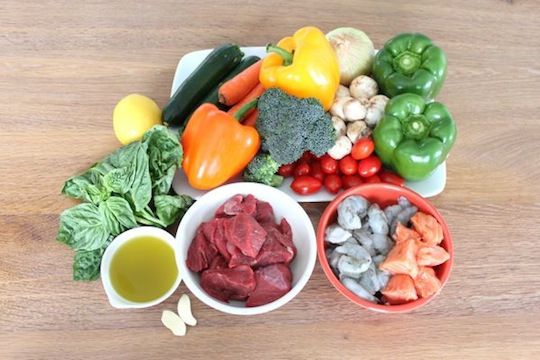
2 pounds of tender, boneless meat. Choose some combination of beef, lamb, pork and chicken. (900 g)
1 pound of fish and/or raw shrimp (peeled and deveined) (450)
1 small head of broccoli
4 carrots
4 bell peppers
1 onion
2 zucchini
1/2 pound mushrooms (230 g)
1/2 pound small tomatoes (such as cherry or plum) (230g)
3 large handfuls of basil leaves
2 to 4 cloves garlic
1/2 cup olive oil (120 ml)
1 tablespoon lemon juice (15 ml)
Salt and pepper
Avocado Sauce:
1 handful of basil leaves
1 avocado, peeled and seeded
1 tablespoon lemon juice (15 ml)
3 tablespoons coconut milk (45 ml)
2 tablespoons olive oil (30 ml)
Salt
Instructions:
Soak wooden skewers in water 30 minutes before using.
Cut the meat either into thin strips 1/4 inch thick and 4 inches long (6 mm and 10 cm) or into 1-inch (2.5 cm) chunks. Place in a large bowl.
Cut the fish into 1-inch chunks. Place in a large bowl (can be combined in a bowl with the shrimp).
Chop the broccoli into florets and cut the carrots into pieces that are about 1/2 inch thick (13 mm) .Steam or microwave the broccoli and carrots until just tender.
Chop the bell peppers, onion and zucchini into pieces that are roughly the same size and thickness.
Cut the mushrooms in half lengthwise.
Put all the vegetables (including tomatoes) in a large bowl or sheet pan.
In a food processor combine the basil leaves with the cloves of garlic, olive oil and lemon juice. Blend until basil leaves and garlic are very finely chopped.
Pour 1/3 of the marinade over the meat, 1/3 over the seafood and 1/3 over the vegetables. Use your hands to mix and evenly coat everything in the marinade. Marinate for 15 minutes at room temperature (or overnight in the refrigerator.)
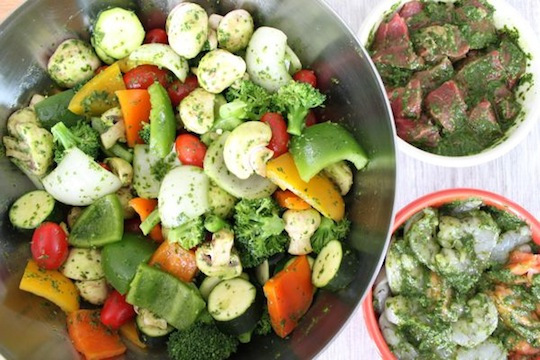
For the most even cooking results, the meat, seafood and veggies should be on their own skewers. However, it’s more fun to combine things. Putting meat and veggies together on some skewers and seafood and veggies together on the other skewers works well.
If the meat is cut into strips, thread it onto the skewers. Chunks of meat and the fish, shrimp and veggies can just be poked through the middle with the skewer. When the skewers are complete, season generously with salt and pepper.
If you get tired of skewering veggies, just skewer some and throw the rest into a large rimmed baking pan. Cook for 12 to 15 minutes under the broiler, stirring several times.
Put the skewers on a grill with medium-high heat or on the top rack of the oven under a broiler on high. Turn twice while cooking. The skewers will cook faster on a grill than under a broiler.
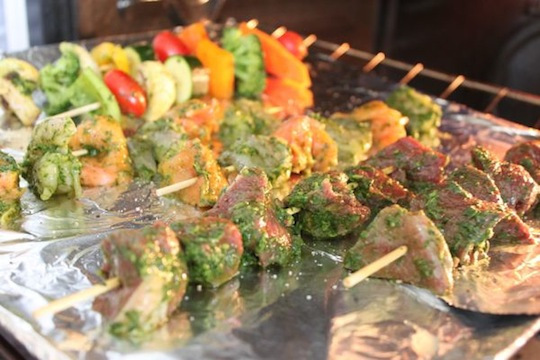
General cooking guidelines:
Meat: 10 to 12 minutes
Fish: 8 to 10 minutes
Shrimp: 6 to 8 minutes
Vegetables: 8 to 12 minutes
Avocado sauce:
Finely chop the basil in the food processor. Scoop the avocado into the food processor and add the lemon juice, coconut milk and olive oil. Blend until smooth. Add salt to taste.
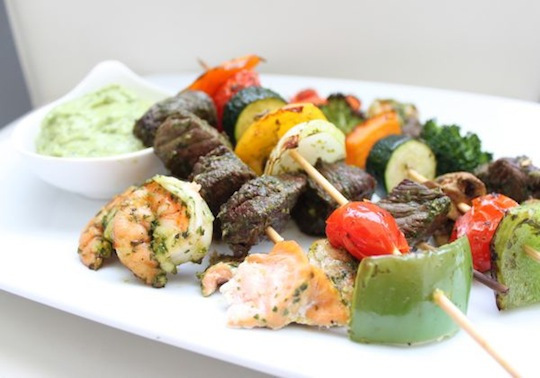
Get All Three Primal Cookbooks, an Apron and More in The Primal Blueprint Chef Kit Today!

March 1, 2013
I Now Feel Like a 21-Year Old Should Feel
It’s Friday, everyone! And that means another Primal Blueprint Real Life Story from a Mark’s Daily Apple reader. If you have your own success story and would like to share it with me and the Mark’s Daily Apple community please contact me here. I’ll continue to publish these each Friday as long as they keep coming in. Thank you for reading!
 Hello Mark!
Hello Mark!
My name is Elizabeth and I’m a college student. This is my story; it’s kind of a long one as I’ve been dieting my whole life! I first came across your site and Nerd Fitness when I was trying to lose weight (for the millionth time) on a calorie counting website. It has completely changed my life! I had been slightly overweight most of my life and near obesity a couple of times. When I was a kid, I was very thin, even under weight. I was a picky eater and I loved to play outside. I had to be dragged in for meals. Then my family moved from beautiful San Diego to Tucson. In the first summer, I nearly had a heat stroke so I stopped playing outside and I think my boredom of being stuck inside changed my eating habits. I started mindlessly eating while in front of the TV and by the time I was 10 I was 150 lbs, and I’m just under 5 ft tall now!
My family was not very understanding and I was teased at school. I honestly hated myself but I didn’t know how to fix it. Then, when I was 12, a cousin told me about a diet she’d done. It was a very restrictive version of Atkins. Basically, phase 1 forever. I lost 30 lbs in less than 2 months. After losing the weight, I didn’t stick to the Atkins-style diet because it was hard and being in a Mexican family, my mom had to cook special meals for me and once I’d lost the weight, my parents figured they didn’t have to do that anymore. I found that eating Mexican food daily while trying to stay healthy was nearly impossible. I had to just barely nibble, and yet I was still a few sizes bigger than I wanted to be. I always felt hungry, but when I ate enough to feel full I usually gained weight and felt guilty.
After a while, I started to feel anxious at the thought of food and going to Mexico to stay with my extended family on school breaks, since they often get together to have cookouts. Sometimes I would notice I was putting on some weight and I’d starve myself with the latest crash diet (lemonade, cabbage soup, fasting, very low calorie, vegan, etc.) then put it back on a few months later and do it all over again. I spent my teens feeling anxiety about eating and spent half of my time starving.
Still, I was overweight! I bounced between 120-130 lbs for years and I felt hungry, lethargic and just awful in general, and I was so upset that after all this effort I always looked and felt terrible. In my final year of high school I had moved out of my parents’ house due to some extreme circumstances, and I signed up for an accelerated program so that I could graduate in my junior year. I essentially finished 1½ years of schooling in ½ a year. This time was very hard for me; I was taking over 10 classes: online, weekend, before school, after school, you name it. I gave up trying to maintain my weight during this time, I was just too exhausted at the end of the day to care what I looked like. I ate burgers and fries every day, pop tarts for breakfast, and starved when I didn’t have the time for food. I put on over 20 lbs in about 5 months. I managed to graduate a year early, and got into the university of my choice, but I was not happy. I was uncomfortable weighing 140+ lbs (I stopped weighing myself after hitting 140), and I once again hated myself for getting there. I went off to college that year with possibly the lowest self-esteem in the freshman class.

As soon as I got there, I went on another crash diet. This time it was a 1000 calorie deal. I figured most people need 1200 but I’m much shorter than most. I was eating a “skinny” Starbucks coffee for breakfast, plain salad for lunch, and a lean cuisine for dinner. I felt awful but I managed to lose around 10 lbs. After that, my weight loss stalled by dieting in this way, so I started some chronic cardio, as you put it, and managed to lose maybe another 5 lbs. I was REALLY stuck there this time, for at least a year, and I would gain those 5 pounds back over school breaks when I went home. I weighed 125-130 again, and I could not lose any more weight doing what I was doing. I was miserable and I felt like a failure but I kept this regimen up because I didn’t know what else to do.

At some point I came across your site on one of the discussion boards of my calorie counting website. I will be honest; I laughed out loud and said to my boyfriend Kyle, “A caveman diet? What will they think of next?” I continued to starve and work out, mostly cardio, but then I got a trainer who started me on something similar to CrossFit, though she didn’t call it that. I didn’t lose a pound, but I did start sleeping all day when I wasn’t in class and I generally stopped moving around other than my workout a few times a week. I was just so tired all the time! I felt like despite all my effort my body was set on turning every morsel of food I ate into fat. While I was being really strict with my diet (as in absolutely perfect) I would maybe lose a pound over the course of a month or two, but then I would party with some friends once in that time or go home for a few days and in just one weekend I would put on everything I lost! It was insanely frustrating and I thought that I must have the worst genes in the world! For this reason I really felt pressured to weigh every ounce of food I ate and I wouldn’t eat things I hadn’t made myself. Eating was really a chore and I often felt anxious about getting it right.
After seeing almost no results, my trainer asked me what I was eating, and I told her. She said that it was too little and said that when I worked out I needed to eat more. Just the thought of eating more made me very anxious. I thought, “what if I put on weight?” and, “How could I eat more if eating one taco and a some refried beans when I went home once in a while put on 2 pounds?” But in the back of my head I remembered your site, and I remembered my first Atkins like dieting experience – how quick the weight loss had been. Since doing that at age 12, I had learned the evils of a very fatty and red meat filled diet thanks to conventional wisdom. I thought I would probably have a heart attack if I tried it again with my family’s history of heart disease, and also I remembered doing the Atkins-like diet was SO boring and took a lot of willpower. But something had to change.
So, I decided to look into Primal more and actually give it a chance this time. I read all of the articles I could find about getting started with Primal and why chronic cardio is bad. I also watched the documentary Fathead and learned more about insulin and what it does to the body and the junk science history of the low-fat movement. I think I read pretty much everything on your website and finally it made sense to me. I realized why I put on pounds so easily. When I go home and eat the food my family makes, it is pretty much as opposite of Primal as food can get. All that insulin spiking, grain full, calorie dense food is the perfect concoction for storing large amounts of fat.
It seems to me that I’m probably more carb sensitive than a lot of people. I say that because I’ve noticed my quicker than average weight gain when I eat them, but it has an equal and opposite reaction. As soon as I stopped eating the grains and started lifting weights rather than cardio (Stacy from a Nerd Fitness story convinced me I wouldn’t look like a guy, another conventional wisdom fact debunked) I lost weight and FAST. I weigh 115 now and some might say that’s not much different, but that’s not the whole story. I lost a ton of inches EVERYWHERE and people tell me that I look like I’ve lost twice what I have all the time! Not to mention, I now feel full of energy, like a 21 year old should feel, and I love the way I look, though I’m still trying to put on some more muscle because why not be hot and strong?
Probably one of the things that has changed the most though is my attitude towards food. The first few weeks of Primal, I really tested the whole eat-what-you-want idea and I was STARVING so I ate and ate and ate, like I’d never been able to do before without fearing weight gain. Shockingly, I still lost weight. Then, even more amazingly, I stopped being so hungry. I no longer feel anxious about eating and I don’t feel guilty after a filling meal. I love food again because I know that I can eat delicious food until I’m satisfied and it’s no big deal. I don’t gain weight!
My boyfriend and I now eat Primal, though being college students we can’t afford organic veggies or meat when we buy it. We do eat the deer he hunts (Axis deer-it’s so delicious!) so I’d say at the moment, about 70% of our meat is free range and organic. We thought we’d miss grains more, but we don’t really. We love the food – the meat’s the best part right? It feels natural and when we need to eat grains because we’re staying with family or something like that, we’ve been able to make it work for us and our lifestyle, and I don’t have to sweat about being perfect with my diet anymore. It seems that now that I’m not starving myself. When I go home and eat my mother’s tacos my body doesn’t try to store every ounce of what I eat. I can’t thank you enough for your website, none of this would have happened without it.
I’ve attached some pictures and you can share these and my story on your site if you’d like. The first one is of me the summer after I graduated high school at my heaviest since I was 12, before attempting to lose any weight. The second pic is me after losing some weight by starving and chronic cardio, but before doing Primal, the summer before last. I stayed about that weight despite all my efforts and the help of a trainer until the start of last summer when I began Primal. The last pic is of me at the end of last summer on a hike in Hawaii, after only a few months of Primal and lifting.
I personally enjoy reading others’ success stories and they are part of what convinced me to give it a try. I hope my story can be a part of that. Sorry for talking your ear off, I tried to make this as short as I could, but that didn’t really happen. Again, thank you so much for the work you are doing – it changed my life.

Sincerely,
Elizabeth
Grab a Copy of The Primal Connection: Follow Your Genetic Blueprint to Health and Happiness Today!

Mark Sisson's Blog
- Mark Sisson's profile
- 199 followers



